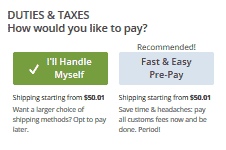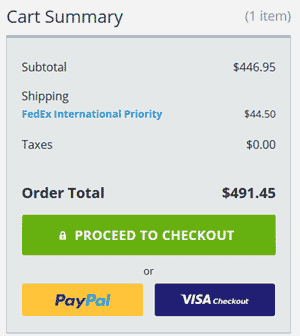The ATO reckons the imposition of the Low Value Imports GST is going gangbusters. Out in the real world, where local retailers have a much sharper focus on the market, opinion is more nuanced.
Since July 1 last year, international retailers selling to the Australian market have been required to register with the ATO, and collect GST for sales under 1000 Australian dollars at the online checkout.
The New Zealand government is about to follow suite on December 1, with the current (and regularly rorted) threshold of GST-free sales for goods up to $400 to be wiped from the statute books. In its place a ‘retailer-collects’ system like the Australian one will be be imposed on goods under $1000 coming into the country. The temptation to rort the NZ system will be even greater, with the GST over there at 15 percent.
How do we know the ATO is pretty pleased with its efforts to enforce the new rules? They told us: ‘GST on sales of low value imported goods into Australia commenced on 1 July 2018,’ said an ATO spokesperson. ‘There are over 1000 overseas businesses registered for GST, including all major international platforms, and as at 1 May 2019, the ATO has collected $250 million in the first nine months of operation, exceeding the full year revenue estimate of $70 million.’
– Sounds like an unqualified success – until you get a reality check from with people with skin in the game:
‘The good news is that Ebay and Amazon are charging GST. But while some of the big online retailers out of Hong Kong, and even B&H did start charging GST, they have now stopped or made it optional,’ a top photo industry executive told Inside Imaging. (Businesspeople we spoke to did not want to be quoted for this story. Understandable when you are contradicting the ATO.)
There do seem to be changes in the marketplace favouring a level playing field however, with some well-known HK-based retailers like DWI, EGlobal and Digital Rev either withdrawing from the Australian marketplace or retailing to Australians via Ebay, where the hassle of collecting GST has been flicked passed to the otherwise tax-avoiding ‘electronic distribution platform’. The ATO has proven the many naysayers somewhat wrong – $250 million in extra tax in just nine months isn’t too shabby – and the formidable and pioneering challenge of bringing international retailers into line could be seen as a ‘Work in Progress’.
But how can the ATO claim all major international platforms are on board when the world’s largest online retailer of photographic goods, New York’s giant B&H Photo & Video, is currently selling sub-$1000 products into Australia GST-free?

In fact, when we first checked last week, B&H was offering Australian customers the option of paying GST at the online checkout (unattractively loaded up with ‘other taxes’ and ‘security & handling’), or ‘handling it themselves’ (nudge, wink).
Perhaps the ATO’s response is also a little ‘nuanced’. While it states that there are ‘over 1000 overseas businesses registered for GST’ it doesn’t actually claim that 1000 0verseas businesses are actually charging their Australian customers GST.

Curiously, when we sent off some questions to B&H – like whether they intended to comply with the obligations imposed by the ATO any time soon, that DIY option disappeared overnight from the checkout process. It is still there for products over $1000.
We think our awkward questions may have encouraged B&H to change its online process for under-$1000 products. Or maybe it was a co-incidence. Either way, local retailers and complying offshore retailers competing against B&H continue to do so at a considerable disadvantage.
These are the questions (unanswered) which we forwarded to B&H: I am just enquiring about how B&H handles the Australian Goods & Services Tax. According to the Australian tax office (ATO), all overseas retailers need to register with the ATO to sell to Australians, and then collect GST for goods under $1000 Australian and remit it to the ATO. However, B&H offers an option of paying the GST at the online checkout, or for the purchaser to handle payment of the tax when the goods are shipped to Australia. If one chooses to have B&H handle the tax, it is loaded up with other costs which in turn inflates the price so it is greater than the 10 percent GST, making this option unattractive. Alternatively, there is an option for the B&H customer to pay the GST at the Australian border. But there is no process by which to do this. Either option seems unsatisfactory – the purchaser is either paying more than the 10 percent GST, or entering an arrangement with B&H to transgress against Australian tax law. Does B&H have any plans in future to comply with the Australian tax law regarding GST?
Also, do you issue tax invoices allowing Australians who purchase products for use in their businesses to claim back the GST paid from the ATO?
(Is it possible B&H was collecting GST when Australian customers chose to pay at checkout and simply banking it? Surely not.)
We asked the ATO whether, under the new law, it was indeed possible to offer customers the option of ‘handling it themselves’ or collecting GST at the checkout, as B&H has been doing:
‘Generally only suppliers that sell $75,000 of ‘low value goods’ (ie, goods with a customs value of $1000 or less) are required to register, collect and remit GST on these sales to consumers in Australia,’ said the ATO spokesperson.

‘These suppliers must collect the GST for these goods at the point they transact with the consumer based on the price paid. There is no option for these suppliers to offer a payment of GST at the border for low value goods.’ (Our italics:)
– That’s pretty definitive, but honoured as much in the breach as in the observance. According to the photo industry executive we spoke to, compliance levels might be something like 40 percent overall, largely thanks to Amazon and Ebay.
In fact in researching this story, Inside Imaging didn’t find any other international online retailers who would issue a tax invoice for GST, even though some, like CCC, claimed that GST was included in the price. The problem for the ATO, and more critically for Australian retailers, is that once Ebay and Amazon see the likes of B&H (and competing NY camera giant Adorama, and a dozen other retailers out of Hong Kong) getting away with ignoring the Australian legal requirements for retailers selling to Australian customers, they will be inclined to follow suite, and the whole system will collapse.
Perhaps some of the rivers of gold flowing into the ATO from offshore sales could be invested back into checking a few more parcels at the border, and better monitoring of and communication with reputable offshore retailers.(Because let’s face it, the rats and mice and their risk-taking customers will always devise a rort.)
When we asked Russell Zimmerman, CEO of the Australian Retailers Association, whether he thought the new rules were working he also referred to the ATO exceeding its estimates ‘by around 300 percent’ as an indication things were working.
He also mentioned a retailers’ group in WA, ‘who regularly write to us claiming another retailer has gone broke because the low-value tax isn’t working. But you have to be very cautious about taking that to the government.’ He said there’s a whole range of factors having a negative impact on retailing.
He anticipated there would be a review of the effectiveness of the tax at some stage which would provide an opportunity for organisations such as the ARA to communicate any concerns to the ATO.
‘At the moment there’s little we can do but bring individual examples to the attention of government.’
He also intimated that at some stage he expected the Australian government to begin geo-blocking sites which were not charging GST on low value imports. So maybe the softly-softly approach has a use-by date!
Here’s a little more input from the ATO, including how to bring any concerns to its attention:
‘The pre-existing import process for “high value goods” – applying any relevant duties, taxes and import processing charges to a consignment of goods with a customs value over $1000 at the border – did not change. There are special rules to prevent double taxation if such a consignment contains low value goods that have already had GST applied at point of sale.
‘The suppliers that collect GST on low value goods include: online marketplaces, merchants, and re-deliverers. Those that sell less than $75,000 worth of taxable supplies (including low value goods) to consumers in Australia per year are not affected.
‘Detailed information is available on our website: www.ato.gov.au/AusGST and our compliance approach at: www.ato.govau/AusGSTCompliance
‘If anyone suspect cases of non-compliance with tax laws, they can report their concerns to the ATO at https://www.ato.gov.au/General/Gen/Report-a-concern/ or by calling 1800 060 062.
– Keith Shipton





Be First to Comment